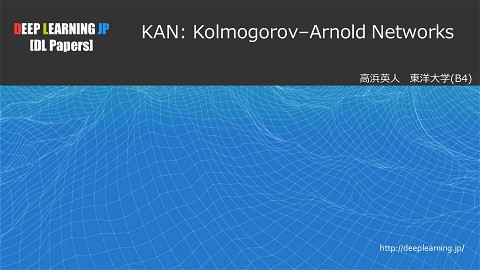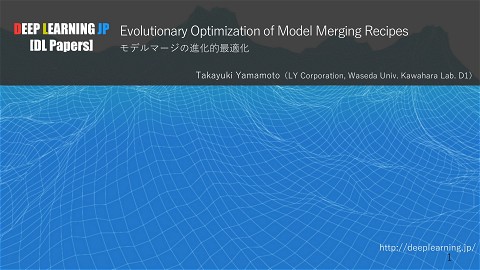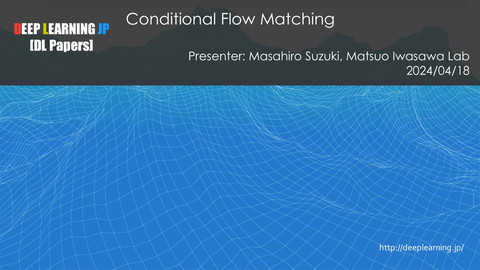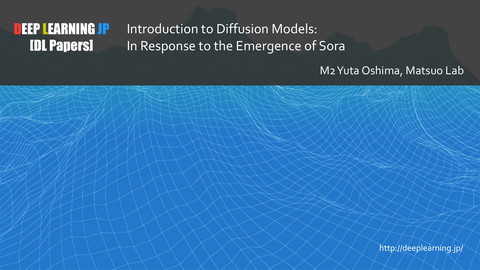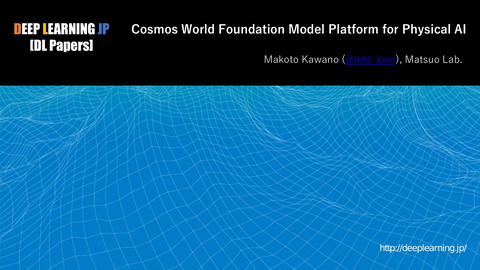[DL輪読会] Learning from Simulated and Unsupervised Images through Adversarial Training
290 Views
September 07, 17
スライド概要
2017/8/28
Deep Learning JP:
http://deeplearning.jp/seminar-2/
DL輪読会資料
関連スライド
各ページのテキスト
Learning from Simulated and Unsupervised Images through Adversarial Training Aug. 28, 2017 ⼯学系研究科システム創成学専攻 杉原祥太
書誌情報 • 著者 • Ashish Shrivastava, Tomas Pfister, Oncel Tuzel, Joshua Susskind, Wenda Wang, Russell Webb • Apple Inc. • CVPR 2017, Best paper award • arXiv: https://arxiv.org/abs/1612.07828 • Presentation: https://youtu.be/P3ayMdNdokg 2
Motivation • ラベル付き実データを⼤量に⽤意す るのは⼤変 • シミュレータで⽣成されたラベル付 きデータは実データとギャップがあ り,思ったように性能が上がらない. • GANのアプローチを⽤いて,シミュ レータで⽣成した画像を,教師なし 学習で実データそっくりに修正する 3
SimGAN 概要 • Refiner • シミュレータによる⽣成画像を Refinerによって実データぽく修正 • シミュレータで得られた付加情報 (視線⽅向など)を保持しつつ, Discriminatorをだますように学習 Self-reg. loss Adversarial loss • Discriminator • Refinerによって⽣成されてデータ と実データを識別 4
関連研究 • Generative Adversarial Nets [Goodfellow et al.(2014)] • GeneratorとDiscriminatorを敵対的に学習 • UnityEyes[Wood et al.(2016)] • シミュレータで⼤量の眼画像を⽣成,最近傍探索で視線推定 • Stacked Multichannel Autoencoder[Zhang et al.(2015)] • スケッチと写真のデータの分布のギャップを学習 • CG2Real[Johnson et al.(2011)] • CGから各部位を推定し,写真による実データを組み合わせて背景画像 ⽣成 5
Training Loss: Discriminator • Discriminator𝐷𝝓 は実データとRefinedデータを識別する Label 1 for refined image Label 0 for real image • パラメータ𝝓はミニバッチごとにSGDにより更新 6
Training Loss: Refiner • 実データ群𝐲$ ∈ 𝒴,シミュレータによる⽣成画像𝐱から,refine 画像𝐱(を⽣成したい.𝐱( ≔ 𝑅𝜽 𝐱 • 𝜽の学習に⽤いるloss: • ℓ-./0 : 実データに似ているか • ℓ-.1 : 付加情報が保存されているか • 𝜓は特徴空間への写像,ここでは恒等写像 7
アルゴリズム • Refiner𝑅𝜽 はstride, poolingなしの 全結合層で実装→全体的な構造が 保存される • ℒ4 𝜽 とℒ5 𝝓 を交代で学習 • 𝑅𝜽 更新時は𝝓固定 • 𝐷𝝓 更新時は𝜽固定 8
Local Adversarial Loss • Discriminatorへの⼊⼒画像をpatchと呼ぶ⼩単位に分割する. • Refinedデータが実データそっくりなら,局所的に⾒ても似て いると考える. • 各patchで実データである確率を計算,loss関数には全ての patchのクロスエントロピーlossの和を与える. 9
Using a History of Refined Images • Discriminatorが最新の⽣成画像のみに従っ て学習してしまう. • Refinerから⽣成された画像は常に”偽物”なのに その影響を忘れる. • Discriminatorは常にこれらの画像を偽物と分類 すべきである. • Refined画像のHistoryからDiscriminatorを 学習 • ミニバッチの半分は現在のRefinerから⽣成され た画像,残りはバッファで蓄えられた画像から 更新する. • イテレータの更新時にバッファの半分をランダ ムに選び,新しいRefined画像に置き換える. 10
データセット • Eye Gaze Estimation • MPIIGaze Dataset[Zhang et al.(2015)] • 214K real images • UnityEyes[Wood et al.(2016)] • 1.2M synthetic images • Hand Pose Estimation • NYU hand pose dataset • 72,757 training frames • 8,251 testing frames • 前処理で224×224にクロッピング 11
Eye Gaze Estimation: 定性的評価 • 視線の⽅向を保ちつつ,肌の質感,センサのノイズ,虹彩の外 観が再現できている. • 𝜓が恒等写像でない場合 • RGBチャネルの平均値 12
Eye Gaze Estimation: Visual Tuning Test • 20枚ずつ例を⾒せた上で,実データとRefinedデータを分類し てもらう(50枚+50枚,被験者10名) • Accuracyは517/1000 𝑝 = 0.148 • 対照的に,実データとオリジナルの⽣成データの分類の Accuracyは168/200 𝑝 ≤ 10@ 13
Eye Gaze Estimation: 定量的評価 • ZhangらのCNNに似た CNN(outputは視線⽅向を表す 3次元ベクトル)を⽤いて学習 • 訓練データによる結果の⽐較 • d=7度以内の誤差を許容する時 の結果の⼀致率 14
Eye Gaze Estimation: 定量的評価 • ネットワークごとでの⽐較 • 提案⼿法が最も優れているこ とを⽰した. • Refinerが視線⽅向をきちんと 保存しているかどうか • 各100個のデータをラベル付け • 差の絶対量は1.1 ± 0.8 px, 瞳の ⼤きさは55 px 15
Hand Pose Estimation: 定性的評価 • 境界部分の不連続といった,実データにおけるノイズが再現で きている. 16
Hand Pose Estimation: 定量的評価 • Refinerによる影響を調べるた め,訓練データによる⽐較のみ • 提案⼿法が最も優れていること を⽰した. 17
Using the History of Refined Imagesの評価 • Without historyでの⽬の周りに ⽣じる不⾃然さが,with history で抑制されている. • 視線推定の誤差が減る • With history: 7.8 degrees • Without history: 12.2 degrees 18
Local Adversarial Lossの評価 • Global adversarial lossでは 境界部分で不⾃然な深度分布 になっているが,Local adversarial lossではそれらが 解消されている. 19
まとめ • Contirutions • ⽣成データをRefineするため教師なし学習を⾏うS+U Learningの提案 • Adversarial lossとself-regularization lossを組み合わせて,Refinerを 学習 • GANの学習の安定化と不⾃然な⽣成を避けるための改良 • 質的量的にシミュレータによるデータ⽣成の⾃然さを向上,Refinerで ⽣成したデータからstate of the artな結果を実現 20
Eye Gaze Estimation: ネットワーク • Refiner Network • EyeGazeEstimation • Input (conv, 55×35, filter3×3) • ResNet (2conv, 64 feature map)×4 • Conv1x1 1 feature map=1 • Discriminator • • • • • • • (1) Conv3x3, stride=2, feature maps=96, (2) Conv3x3, stride=2, feature maps=64 (3) MaxPool3x3, stride=1 (4) Conv3x3, stride=1, feature maps=32 (5) Conv1x1, stride=1, feature maps=32 (6) Conv1x1, stride=1, feature maps=2 (7) Softmax. • • • • • • • • • • • • Input 35x55 grayscale (1) Conv3x3, feature maps=32 (2) Conv3x3, feature maps=32 (3) Conv3x3, feature maps=64 (4) Max- Pool3x3, stride=2 (5) Conv3x3, feature maps=80 (6) Conv3x3, feature maps=192 (7) MaxPool2x2, stride=2 (8) FC9600 (9) FC1000 (10) FC3 (11) Euclidean loss 21
Hand Pose Estimation : ネットワーク • Refiner Network • EyeGazeEstimation • Input (conv, 224x224, filter7x7) • ResNet (2conv, 64 feature map)×10 • Conv1x1 1 feature map=1 • Discriminator • • • • • • • (1) Conv7x7, stride=4, feature maps=96 (2) Conv5x5, stride=2, feature maps=64 (3) MaxPool3x3, stride=2 (4) Conv3x3, stride=2, feature maps=32 (5) Conv1x1, stride=1, feature maps=32 (6) Conv1x1, stride=1, feature maps=2, (7) Softmax • Input 224x224 grayscale • Hourglass blocks x2 • Conv7x7, stride=2 • Residual module • maxpooling • Output 64x64 22

